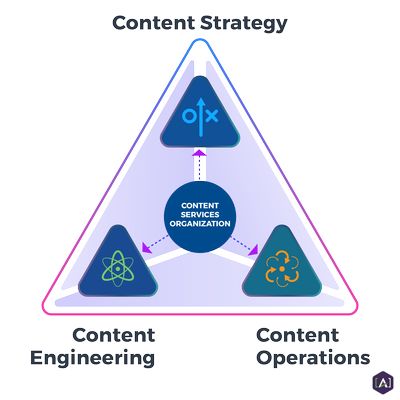Content Engineering can help address content challenges that fairly typical organizations face. Such as, some metadata and taxonomy is in use, but there are no standards – one version is used by marketing and another is used by other divisions. Although some content structure is employed, much of the content is still authored in unstructured “blobs” with MS Words. The content remains “unfindable” for internal use and is not optimized to match customer journeys. Despite their best efforts, the team is not achieving their SEO goals.
This scenario may seem overwhelming, but the solution is not. As described below, Content Engineering puts in place practices for organizing content at time of creation, and optimizing it for a variety of applications. In this article we explore just what Content Engineering is and how it can help you achieve better results with intelligent content.
1. Common issues enterprises face that can be solved with Content Engineering
[A]’s experience working with large organizations reveals that many organizations work with content in very siloed ways, with many internal obstacles, inefficient operational processes and organizational structures and outdated technology.
These inefficiencies translate into:
- Longer authoring, publication and distribution cycles (Content Supply chain)
- Underperforming ROI
- Poor User Experience (UX)
- Underperforming customer retention
Some of the most common Content related problems that can be resolved though Content Engineering are:
- Siloed content supply chains
- Duplicate content in a myriad of formats
- Inefficient content authoring workflows
- Chunky, unstructured content
- Outdated technology
- Technology in place does not match needs
- Inability to reuse content across channels (multi-channel content)
- Metadata and Schema are not used
- Lack of standards for metadata
- Lack of findability of content for internal and external use
- Poor SEO performance
- Inability to implement personalization
To make this level of personalized multi-channel delivery and reuse of content possible, operations, people and technology need to be aligned.
For these elements to work together efficiently, successful enterprises share a common foundation, Content Engineering.
2. What Is Content Engineering?
Content engineering is the practice of organizing the shape and structure of content by deploying content models, in authoring and publishing processes in a manner that meets the requirements of an organization’s Content Strategy, and its implementation through the use of technology such as CMS, XML, Schema, AI, APIs and others.
Content Engineering consists of several primary disciplines:
model,
metadata,
markup,
schema,
taxonomy, and
graphs.

Model – Content modeling creates a representation of types of content, their elements, attributes, and their interdependent relationships.
 Metadata
Metadata – Metadata is content that provides useful, but generally not visible information about other content. Metadata helps applications, authors, and robots use and relate the content in smart ways.
 Markup
Markup – Broadly speaking, markup is everything wrapping content that’s not the content itself. Markup describes and presents content and can include XML and content transformations.
 Schema
Schema – Schema is a form of metadata that provides meaning and relationships to content. Schema often involves published standard vocabularies, such as schema.org, for describing concepts with standardized terms. Schema enables robots to understand and relate ideas.
 Taxonomy
Taxonomy – A map of related concepts that are applied to content, often as tags. Taxonomy shows content relationships by enabling dynamic collections of content items. It enables and supports features like related content reuse, search, navigation, and personalization.
 Graph
Graph – Graph architecture and design competencies help to connect various parts of an enterprise content ecosystem and customer data platform. Graphs form node-based relationships between customer states and the modular content needed to deliver fluid, personalized experiences.
3. Benefits of Content Engineering for your organization
Most enterprises can benefit from integrating a Content Engineering practice with real short and long term operational, commercial and financial benefits ranging from:
- Better, more efficient collaboration across teams and departments for content creation
- Standardized content formats that enable easy reuse
- Faster publishing
- Lower costs
- Improved Customer Experience
- Higher Customer retention
3.1 Content Engineering for Customer Experience Management
Content engineering fuels customer experience management. It enables content to shape itself in discrete, structured formats for adaptive use across desktop, tablet, mobile experiences, and print products. Content must transform for implicit and explicit content personalization.
Multi-Channel content supported across devices, contexts, and platforms requires thoughtful architecture and planning. Customer journeys take place on owned properties, but also in search, social, native mobile applications, and syndicated views of the publisher’s infrastructure. The content must be properly engineered to facilitate that reach.
Customer experience management leaders outperform their market peers. A content engineering practice is not optional for organizations intending to orchestrate digital customer experiences.
3.2 Content Engineering for Multi-Channel Content
Content assets become more valuable the more they are discovered by humans and used as part of customer journeys.
Content engineering is the practice most accountable for an organization’s ability to design multi-channel content that can be elegantly reused in multiple digital properties, applications, and workflows at low cost.
3.3 Content Engineering for Machine Learning, Artificial Intelligence, and Cognitive Computing
Robots need structured content to effectively provide answers and value to humans. Google, Siri, Cortana, Alexa, Watson, and others function on the basis of understanding relationships between semantic concepts. In order for organizations to develop presence and authority, content engineering must be employed to create meaningful machine-consumable content and interactions between robots and humans.
As intelligent agents become a bigger part of the way organizations understand themselves, their vendors, customers, and the world around them, structured content increasingly becomes a pathway to relevance in a cognitive era.
3.4 Content Engineering for SEO (Search Engine Optimization)
Search engines and Google in particular are promoting the use of structured content and Schema.org markup and metadata.
Schema markup, also known as Schema, is a semantic vocabulary of standardized tags that are added to the page’s HTML. These tags help search engines understand the content and context of your webpage and better represent it in search results. Content Engineering facilitates the use of Schema by incorporating it in the Core Content Model, in the authoring process and by automating the transfer of that metadata from CMS to Google.
Schema provides an important standard for metadata and provides a basis to communicate semantics about unstructured and structured data.
Download the Free Schema Guide |
|
 |
Google uses the Schema metadata for displaying results in numerous formats other than the traditional blue links. Some examples include:
a. Navigation Schema Markup
Listing up to six pages below your site’s title tag and meta description, you can use the site navigation schema markup to point users directly to your site’s primary subpages. Each site link can have unique title tags and meta descriptions for your site’s subpages.
 b. Organization Schema Markup
b. Organization Schema Markup
The organization schema shows users a quick summary of your organization's main information points: a short description of the organization, the company logo, location, contact information and links to the company’s social media profiles.
c. Event Schema Markup
The event schema markup is a great way to show users relevant information on the search results page about upcoming podcasts and webinars or events/conferences that you participate in.
Details such as date, price, and location (physical or URL) can be displayed below the meta description of your search result. The Events information displays at the bottom in the Organization box.
 d. Person Schema Markup
d. Person Schema Markup
The Person markup communicates basic information about an individual mentioned on the page to search engines.
The Person markup helps Google identify an individual as an entity. By adding more schemas, like Organization, for example, you’re helping Google establish relations between different entities.
The tangible benefit of applying the Person Schema may be a comprehensive Knowledge Graph with all the details about a certain person.
 e. Image Schema Markup
e. Image Schema Markup
Images, as well as videos, are a perfect example of unstructured content but adding structured data in the form of Schema markup to provide contextual information to an image can help search engines display your images as rich results and improve its findability. This is a great way to increase visibility of your company/brand.
Benefits of Schema markup for SEO
- Rich results - Better visibility in Search results
- Better User Experience
- Search Optimization of unstructured content (image, video, voice)
What is the value of Schema markup for your business
- Increased CTR (Click-Through-Rate)
- More traffic
- Increased ROI
3.5 Content Engineering for Digital Transformation
Organizations have a vast array of digital assets. They have the systems and the content. The challenge now is utilizing those assets in intelligent ways.
Content and data assets need to be empowered to move seamlessly across organizational silos, web services, search tools, CRM, CMS and DXP platforms. Content must be fluid like a liquid, moving, transforming and adapting to the shape of its output channel in order to power organizations. For many organizations, content is more like a rock: monolithic, inflexible and almost impossible to move.
Content engineering gives organizations a super power. Engineered content assets can be used in many places at once, related, discovered, and used to deliver value at the fastest possible throughput.

But content engineering is only one pillar of a
Content Services Organization. The practice of
content engineering must be aligned with content strategy and
content operations to manage the standards and the patterns that create intelligence.
Adaptive organizations start with strategy, power that strategy with engineering, and wrap it in operations to bring content to life.
Together they make intelligent digital transformation a reality.
4. A successful Content Engineering Practice starts with teamwork
Creating and delivering engaging content experiences to customers across multiple channels challenges even the largest organizations. Add on personalization, interaction, and a myriad of device types, and it’s no wonder marketing technologists have trouble keeping up!
Content engineering bridges the gaps between strategy and development. Working with content strategy, content engineering transforms static content into a form that’s modular, intelligent, structured, and standardized. Sophisticated content that is designed for reuse – multi-channel content – requires thoughtful architecture and planning. It takes engineering and teamwork.
If the team is managed in a way that encourages continuous learning and an open dialog about the team’s constraints and limitations, the content engineer(s) will be the key to identifying what needs your organization has in terms of other content support. They will know if they need programmers to automate content processes, they’ll recognize when taxonomy requirements have become so complex they’re in way over their head, and they’ll identify areas where machine learning expertise will provide significant lift.
In this way, content engineering principles are at the center of the organization, but the team may grow to include members from other disciplines. Think about building and growing a content engineering organization as a wheel with spokes. At the center is the content engineer role.
4.1 The Role of the Content Engineer
Based on the requirements defined by the content strategist, a content engineer focuses on defining the technical requirements of content and defining and maintaining the Core Content Model for the organization.
Some of the tasks include:
- Identify how content can be modularized for automatic reuse
- Develop format-free structured content models for multi-channel rendering
- Define the structure of the CMS repository to support authoring and content retrieval.
- Develop metadata to tag all content modules for personalized content retrieval.
- Develop business rules to identify how content should be assembled automatically upon customer request.
- Determine how to optimize the content supply chain from authoring, storage, publication to distribution.
- Determine how content has to be structured and tagged to support chatbots, natural language generation/automatic content generation, and AI.
- And much more.
Typical responsibilities for a content engineer include the design and development of:
- Content models
- Reuse strategy
- Taxonomy and metadata
- Governance
- Technology selection and configuration
4.2 Content Strategy meets Content Engineering
The content strategy and the content engineering roles work together, jointly, with an
information architect or user experience designer. Shared deliverables include a detailed content model,
taxonomy, CMS implementation and management specifications, personalization plan, and content reuse worksheet.
Think of the content strategist as the CEO of content and the content engineer the CTO of content. They complement each other to deliver optimal value.
- The content strategist plans for the creation, publication, and governance of useful, usable content. Content strategy targets the ‘who, what, when, where, and why’ of content experiences and assets.
- The content engineer organizes the shape, structure, and application of content assets. Content engineering targets the ‘how’ of content assets, platforms, and publication.
Together, they work to specify how audiences should receive content, how devices should display content, and how content can be Multi-Channel.
Benefits of successful content strategy and content engineering collaboration:
- An ever-increasing value of content assets
- Decreasing costs for publishing content assets
- Improved customer experiences
- Make content technology software investments both accomplish more and operate more efficiently
5. Get help from Content Engineering experts
[A]’s content engineers are experts with years of experience in implementing Content Engineering practices in large organizations. They help clients realize the value of existing content assets and extend value through innovation and content enrichment.
[A] assists Organizations adopting Content Engineering practices through a number of services:
- Audits of your current organizational structure, available (human) resources and technology
- Consulting on Content Engineering implementation
- Workshops on Content Engineering for Management
- Guiding your organizations’ Digital Transformations to adopt content engineering
- Manage content engineering practices for organizations
Contact Us for a Free Consultation.